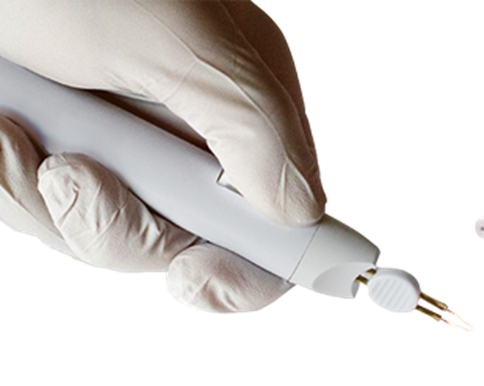Electric needle treatment (cauterization)

Treatment using cauterization - an electric needle is actually causing a precise and controlled heat burn to remove skin lesions including:
Skin warts are small skin bumps based on a narrow stalk that often appear on the skin of the neck, eyelids, armpits, chest folds and sometimes also in other skin areas. The background is often hereditary and there is also a strong connection to overweight.Corneal lesions and warts can also be hereditary (seborrheic keratoses) or infectious - viral warts of various types (Molluscum contagiosum, Verruca vulgaris). can appear on the skin of the face as well as on other areas of the body, especially on the shoulders, back and chest and on the eyebrows of the hands and forearms.
Actinic keratoses often appear in areas exposed to the sun - precancerous lesions secondary to solar radiation. These lesions usually appear in the areas exposed to the sun, on the skin of the face, limbs and body, usually against the background of a lot of exposure to the sun and usually in patients with a light skin tone. This is a common problem that is a marker for an increased risk of skin cancer.
The advantage of the treatment using an electric needle is its availability, the possibility to regulate its strength and direct it precisely to the treated lesions without damaging the surrounding healthy skin and the possibility to repeat the treatment from time to time.
The pain of the treatment involves immediate pain, sometimes intense, which usually subsides within a few minutes (10-15). Normal sedatives in pain pills are usually sufficient to relieve the pain.After the treatment, immediately after the treatment, the skin becomes reddish around the lesions - a phenomenon that usually disappears within 15 minutes, but can sometimes continue for several hours. Afterwards, fine golden-brown scabs usually appear on the skin, which peel off on their own within a few days (up to two weeks). In patients with particularly sensitive skin, redness and even delicate superficial blisters and discharge of yellowish and sticky tissue fluid may appear immediately after the treatment. These phenomena do not constitute a malfunction in themselves, and they also pass within a few days (up to 3 weeks). If they appear, do not open blisters or remove scabs. Bathe as usual and apply moisturizer to the treated skin. If a wound or blister appears at the treatment site, you can apply antibiotic ointment and/or bandage and cover the area. Do not stick plasters or tapes on the burn itself.
After recovery, redness remains in the treated area, which gradually disappears within a few weeks until returning to the normal skin tone.It is recommended to avoid exposing the area to the sun without protective measures until complete recoveryץ
The risks of this treatment are related to the patient's skin type. In patients of dark-skinned ethnic origin and in those who have dark skin themselves, there is a 10% risk of the appearance of a dark spot secondary to a burn, resulting from the deposition of pigment in the skin as a result of the inflammation during the recovery process from the treatment or a pale/white spot resulting from the development of a scar in which the pigment-producing cells have been damaged. In most cases, these spots disappear after several months when the patient is careful to avoid exposure to the sun.
Dr. Gilead has a lot of experience with cauterization and uses it in the clinic.
Cauteriztion treatments are not included in the consultation visit and are charged separately


